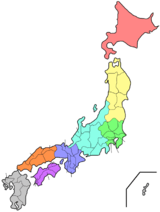Going broke universities – Disappearing universities
The Going broke universities – Disappearing universities (危ない大学・消える大学 Abunai Daigaku Kieru Daigaku) is a ranking book about Japanese Universities by Japanese journalist Kiyoshi Shimano, published annually since 1993.
Although there are several university rankings in Japan, most of them rank universities by their entrance difficulties often called "Hensachi" or by alumni's successes. Especially, the Hensachi Rankings have been most commonly used for university ranking.[1] From this view point, GBUDU is a typical ranking book in Japan.
The GBUDU ranks Japanese Universities in terms of the entrance difficulty and selectivity. The author's main argument is that more selective universities have better quality, and generally guarantee students better future careers. Thus people should avoid least selective universities, and try to enter more selective ones as much as they can.[2][3][4]
Methodology
The GBUDU rankings are made by the average scores of Hensachi estimated by Japanese major prep school Yoyogi seminar.[2] Consequently, it can be regarded as a summary of the selectivity of Japanese universities.[5][6][7]
He prepared the following 10 scales to measure universities' entrance difficulties.
| SA | Most selective | 15 |
| A1 | Very selective (Upper 1st class) | 46 |
| A2 | Very selective (Lower 1st class) | 149 |
| B | Selective (Almost equivalent to 1st class) | 22 |
| C | Upper middle class | |
| D | Middle class | |
| E | Lower middle class / He defined it as the minimum level of universities that student should enter | |
| F | Lower class | |
| G | Lower class | |
| N | Least selective / The candidate universities for "Going broke universities" or "Disappearing universities" | |
| Total | [13] 778 | |
2010 rankings
The following data is the 2010 ranking table in Rank SA - Rank B.[14]
References
- 増田 晶文 "大学は学生に何ができるか" 2003
- "危ない大学・消える大学 2012年版" (in Japanese). YELL books. 2011.
- However, it is not always true that more selective universities are better for job hunting (e.g. universities in big cities such as Greater Tokyo and Greater Osaka are more competitive in Japanese job market). In fact, Shimano also regularly publishes another ranking book from this perspective (see the reference below).
- "就職でトクする大学・損する大学ランキング 2012年版" (in Japanese). YELL books. 2011.
- Usually prep schools provide rankings in each subject, but rarely do the whole university rankings. From this point of view, GBUDU is one of few publications which provide this data.
- However this ranking system doesn't include several small specialist universities. For example, all of the independent medical schools are not considered, although their entrance difficulties are highly competitive. Therefore, this ranking system only includes major universities.
- Normally, National/Public Universities and Private Universities use different sort of exams, so it's not easily comparable. Hensachi scores have a tendency to be higher with Private Universities. Shimano applies his own measurement to fix this tendency to make it more realistic.
- This data is computed from the cumulative number of students in each group per Japanese population at 18(1,220,000 ), and all Japanese university students at 18(60% of the population, i.e. 732,000 ).
- The number of undergraduate students in the same year in SA is 47,353, in A1 is 82,970, in A2 is 91,938, and in B is 37,781.
- This counted number includes international students, so rigorously, the national selectivity would be smaller than these numbers. For example, The selectivity of SA without international students is 3.8% and 6.4% (originally 3.9% and 6.5%).
- Hensachi is a statistic indicator which represents a position of a sample group. The 50 of Hensachi means average, above 50 means higher than average, and below 50 means lower than average.
It is estimated by using the following equation.
Hensachi = [z-score] x 10 + 50.
The Hensachi in this diagram is calculated from the selectivity percentage (i.e. one-tailed P-value). - some vocational schools are reasonably selective. Thus it doesn't mean all university students are academically more talented than non-university students. Plus, the academic ability also depends on the subject and field of study. Therefore, we have to see the diagram as a rough indication.
- According to MEXT, there are 86 national universities, 95 public universities, and 597 private universities in 2010. Archived 2011-03-23 at the Wayback Machine In addition, there are also 26 public 2 year colleges and 369 private 2 year colleges, thus we often also count this number in the total number of universities (i.e. 1173 universities). However this ranking book doesn't contain 2 year colleges.
- "危ない大学・消える大学 2010年版" (in Japanese). YELL books. 2009.
